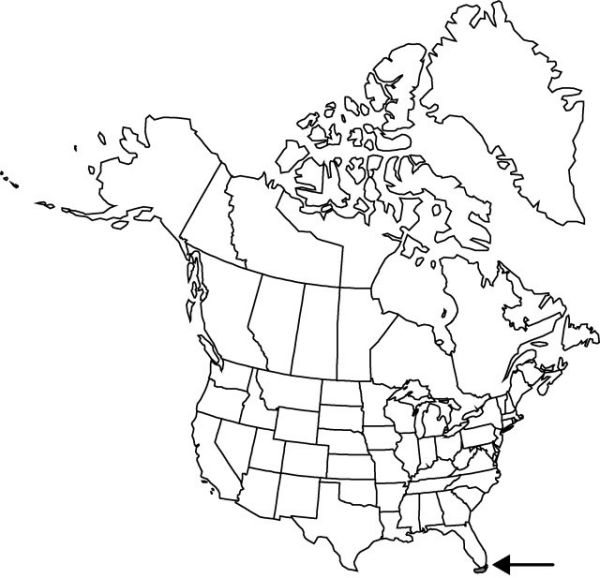Difference between revisions of "Agave sisalana"
Trop. Pl., 87. 1838.
FNA>Volume Importer |
imported>Volume Importer |
||
| (6 intermediate revisions by 2 users not shown) | |||
| Line 8: | Line 8: | ||
}} | }} | ||
|common_names=Sisal | |common_names=Sisal | ||
| + | |special_status={{Treatment/ID/Special_status | ||
| + | |code=I | ||
| + | |label=Introduced | ||
| + | }} | ||
|basionyms= | |basionyms= | ||
|synonyms= | |synonyms= | ||
| Line 24: | Line 28: | ||
|elevation=0 m | |elevation=0 m | ||
|distribution=Fla.;s Mexico. | |distribution=Fla.;s Mexico. | ||
| − | |discussion=<p>Agave sisalana is frequently cultivated for its fiber and ornamental value. The plant is not known from the wild. As with A. desmettiana, capsules and seeds of this species are unknown. Capsules are known from A. kewensis (native to Chiapas), A. neglecta, and A. weberi, although no mature seeds have been observed. It may be that all are anciently selected cultivars that now persist only by vegetative means. None save A. kewensis is thought to occur in the wild. Plants similar to those found in Florida are known from Chiapas. Agave sisalana is an important source of fiber and probably was widely distributed by pre-Columbian people.</p> | + | |introduced=true |
| + | |discussion=<p><i>Agave sisalana</i> is frequently cultivated for its fiber and ornamental value. The plant is not known from the wild. As with <i>A. desmettiana</i>, capsules and seeds of this species are unknown. Capsules are known from A. kewensis (native to Chiapas), <i>A. neglecta</i>, and <i>A. weberi</i>, although no mature seeds have been observed. It may be that all are anciently selected cultivars that now persist only by vegetative means. None save A. kewensis is thought to occur in the wild. Plants similar to those found in Florida are known from Chiapas. <i>Agave sisalana</i> is an important source of fiber and probably was widely distributed by pre-Columbian people.</p> | ||
|tables= | |tables= | ||
|references= | |references= | ||
| Line 33: | Line 38: | ||
-->{{#Taxon: | -->{{#Taxon: | ||
name=Agave sisalana | name=Agave sisalana | ||
| − | |||
|authority=Perrine | |authority=Perrine | ||
|rank=species | |rank=species | ||
| Line 48: | Line 52: | ||
|publication title=Trop. Pl., | |publication title=Trop. Pl., | ||
|publication year=1838 | |publication year=1838 | ||
| − | |special status= | + | |special status=Introduced |
| − | |source xml=https:// | + | |source xml=https://bitbucket.org/aafc-mbb/fna-data-curation/src/2e0870ddd59836b60bcf96646a41e87ea5a5943a/coarse_grained_fna_xml/V26/V26_944.xml |
|genus=Agave | |genus=Agave | ||
|species=Agave sisalana | |species=Agave sisalana | ||
Latest revision as of 22:18, 5 November 2020
Plants short-stemmed, commonly suckering with elongate rhizomes, trunks 0.4–1 m; rosettes not cespitose, 15–20 × 15–25 dm. Leaves spreading, 90–130 × 9–12 cm; blade green, slightly cross-zoned when immature, lanceolate, firm, adaxially plane, abaxially slightly convex; margins straight, finely fibrous, typically unarmed, teeth single prickles when present, 1–2 mm, 2–5+ cm apart; apical spine dark brown, subulate, 2–2.5 cm. Scape 5–6 m. Inflorescences paniculate, open, often bulbiferous; bracts persistent, triangular, 0.5–2 cm; lateral branches 10–15(–25), ascending, comprising distal 1/2 of inflorescence, longer than 10 cm. Flowers erect, 5.5–6.5 cm; perianth greenish yellow, tube urceolate, 15–18 × 10–12 mm, limb lobes erect, equal, 17–18 mm; stamens long-exserted; filaments inserted ca. mid perianth tube, erect, yellow, 5–6 cm; anthers yellow, 20–25 mm; ovary 2–2.5 cm, neck slightly constricted, 2–4 mm. Capsules not seen. Seeds unknown. 2n = 138, 147, 149, 150.
Phenology: Flowering winter–early spring.
Habitat: Sandy places along roadsides and in hammocks
Elevation: 0 m
Distribution

Introduced; Fla., s Mexico.
Discussion
Agave sisalana is frequently cultivated for its fiber and ornamental value. The plant is not known from the wild. As with A. desmettiana, capsules and seeds of this species are unknown. Capsules are known from A. kewensis (native to Chiapas), A. neglecta, and A. weberi, although no mature seeds have been observed. It may be that all are anciently selected cultivars that now persist only by vegetative means. None save A. kewensis is thought to occur in the wild. Plants similar to those found in Florida are known from Chiapas. Agave sisalana is an important source of fiber and probably was widely distributed by pre-Columbian people.
Selected References
None.